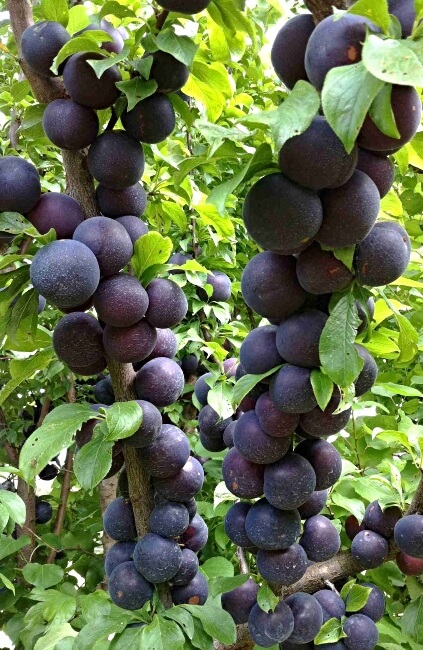Plumcots might sound like a gimmick, but they’re a fairly natural cultivar of two plants in the Prunus genus, apricots and plums, and have some of the best flavour profiles of both. If you’re in a cooler part of Australia, it's definitely worth growing your own plumcot tree.
More...
Family: | Rosaceae |
|---|---|
Genus: | Prunus |
Species: | Prunus salicina × Prunus armeniaca |
Common names: | Plumcot, Plumscrumptious (specific cultivar) |
Origin: | Cultivated |
Location: | Outdoor |
Type: | Edible, Fruit Tree |
Growth: | 3m x 3m |
Sun requirements: | Full sun |
Foliage colour: | Green |
Flower colour: | White |
Flowering: | Spring |
Edible parts: | Fruit |
Maintenance level: | Low - Medium |
Poisonous for pets: | Leaves, stems and pits are toxic to pets |
About Plumcot Trees

Plumcots are a hybrid between Japanese plums (Prunus salicina) and apricots (Prunus armeniaca). There are three main groupings of this hybridisation; plumcot, aprium and pluot.
- Plumcot: Generally 50% apricot and 50% plum
- Pluot: Around 75% plum and 25% apricot
- Aprium: Around 75% apricot and 25% plum
In our experience, plumcots grow best across the widest range of Australian climates and have a few very useful cultivars to help with cropping depending on where you live.
While dwarf plumcots are possible, most are sold on more vigorous rootstocks, producing taller trees of around 3m tall, and 3m wide, each producing a plum-coloured fruit with a pale russet-coloured flesh.
They are bred primarily for their sweetness, being significantly sweeter than either plums or apricots separately, and offering the fragrance of an apricot with the juicer texture of a plum.
Popular Plumcot Cultivars and Where to Grow Them
There are numerous cultivars of plumcots, cross-bred with cultivars of apricot (Prunus armeniaca) and the Japanese plum (Prunus salicina) specifically to retain the moniker ‘Plumcot’. Three of the most useful for Australian gardens are Plumscrumptious, Flavour King and Spring Satin.
Plumscrumptious
Plumscrumptious is an early-fruiting variety, with fruits in early summer. It requires cooler climates and benefits from a winter chill period, similar to cherries, for a successful crop in Australia.
It is not self-pollinating so it requires a second plumcot, plum or apricot tree to pollinate flowers in early spring.
Flavour King
Flavour King is a very useful plumcot cultivar for Australian gardeners as it doesn’t require a significant winter chill. Like all Prunus plants, seasonal change, winter leaf drop, and new spring growth all contribute to better fruit, but Flavour King will crop after a very mild winter.
Spring Satin
Spring Satin is the best plumcot to grow if you’re growing for flavour alone, but like Plumscrumptious, it does require some winter chill. It is ok without frost, but temperatures below 10°C for at least a month are required for optimum cropping.
In tests and cultivation trials, the fruit was shown to have 33% sugar content, and when ripe, an incredible plum-like juiciness, that outshines all other cultivars for flavour.
How to Grow Plumcot Trees
Plumcot trees are actually pretty easy to grow. They like full sun and plenty of summer irrigation, and they don’t mind winter wet as long as the trunk itself stays dry.
The main thing any plumcot grower needs to provide is nutrition. This is best done at the time of planting, by adding loads of compost, well-rotted manure, or whatever organic loamy materials you have to hand.
Liquid feeds don’t do much for plums and plumcot trees, so focus on mulching annually to maintain a good balance of nutrients and natural minerals in the soil.


Get Your Free Guide:
Master Growing Australian Natives eBook
A Must Have Complete Guide for Every Australian Garden
Get Your Free Guide:
Master Growing Australian Natives eBook
A Must Have Complete Guide for Every Australian Garden

Source: PlantNet
How to Propagate Plumcot Trees
Plumcot trees will cross-pollinate with other members of the plum family so unless they are grown indoors or under glass (not advised due to their need for winter chill) they rarely produce true-to-form plants from seed.
Instead, take cuttings from semi-ripe wood in summer. This will produce a perfect duplicate of the original tree, ready for cropping in around five years (when the trunk is about 5cm in diameter).
This method will also allow you to create patio plumcots, with the cutting grafted to a dwarf plum rootstock, offering you plumcots that can be grown on a balcony or in a small garden.
Planting Plumcot Trees
Plumcot trees are readily available all year round and can be planted any time between late winter and early autumn. Avoid planting in winter as the roots are slow to establish in cooler conditions and this can lead to root rot before spring.
In spring and early summer, plumcot trees are also available as bare-root plants from many online suppliers across Australia. Bare-root plants are much cheaper than potted trees and establish faster, but planting them is a little different.
To plant a bare-root plumcot, soak the root ball in water as soon as it is delivered. While it soaks, dig a hole slightly bigger than the width of the roots when spread out fully, and loosen the base of the planting hole slightly.
Lay the roots out across the planting hole as laterally as possible, and stake the tree before filling in with soil for extra stability. Then lightly moisten the base of the soil to stop the root from drying out again.
Finally, fill the planting hole with a mix of your own topsoil and organic compost before gently treading the surface of the soil to firm it in and soaking the area with several buckets of water.
Water weekly for its first year. By next summer you should have a cropping plumcot tree!
Plumcot Tree Care
It’s important to continue with a simple care regime for plumcots. They’re not particularly fussy, but like any plants you’re growing for food, they do need a bit of love to do their best work.
For plumcot trees that means watering regularly in spring after flowering to provide enough water for developing fruits, and continuing to water during any dry weather in summer as the stems to produce next year’s crop develop.
In late winter, when the weather begins to warm, mulch your plumcot tree with organic compost, or sprinkle pelletised chicken manure. This feeds the tree for the season ahead and helps to retain soil moisture through summer.

Source: Perfect Plants
Common Problems When Growing Plumcots
The most common problem when growing any plum tree, plumcots included, is lack of pollination. If you’ve got another plumcot tree nearby (or apricot or plum for that matter) you should be ok but it's still important to encourage pollinators into your garden by growing a range of open flowers and nectar-rich natives.
The next big issue is pests. There are a few boring insects and wasps that are attracted to ripe and ripening plumcots, but if you pick them early it shouldn’t be an issue, but birds are a particular frustration as they peck at unripe plumcots to test them.
Consider covering your trees or growing them in a netted fruit cage if possible. Otherwise, just accept that some of your crops might need to be shared with garden visitors.
Harvesting & Storing Plumscrumptious
Harvest plumcots before they are ripe unless you are going to eat them straight away. Plumcots, like plums, store very badly and can go from perfectly ripe to mush in a matter of hours.
The best way to store plumcots for longer periods is by freezing them, which will give you the flavour of fresh plumcots all year round, ready for stewing and baking, but they will lose their texture when defrosted.
I like to lightly stew plumcots with no other ingredients in a simmering pan just until they break down enough to blend into a pulp. That pulp can then be frozen as ice cubes and stored in a freezer bag. It can be added to smoothies for a kick of natural sugar whenever you need a boost.
And finally, and perhaps most obviously, jam. Why else would you want to grow a plum with the flavour of an apricot and twice the sugar content? It’s like they were made for jams and preserves. A hint of cinnamon and a few cloves add something really special to any plumcot preserve.
Wrapping Up Our Plumcot Tree Guide
Plumcots are unusual trees, but still pretty easy to grow. As long as you’ve got a decent base of garden soil and add a generous amount of goodness with mulch each year, they’ll keep being productive indefinitely.
Plus, growing your own plumcots is a fun way to show off to garden guests. Offering them what will almost definitely be the sweetest, most fragrant plum they’ve ever eaten is sure to make your garden a popular spot.
Published on October 8, 2025 by Gary Clarke
Last Updated on October 16, 2025




